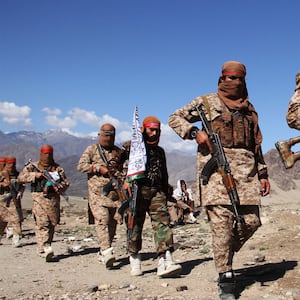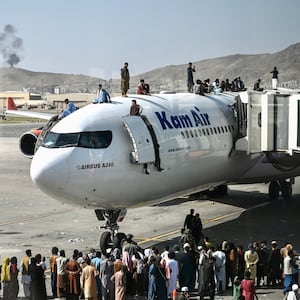The Taliban triumph in Afghanistan has given a new lease on life to the world’s Islamic extremists, and neighbors far and near including Russia and China had better watch out.
Osama bin Laden wasn’t the only jihadist to find sanctuary in Afghanistan and use it as a base for attacks when the Taliban last held power from 1996 to 2001. From China to Chechnya and throughout the Arab world, jihadists came for military training and combat as the Taliban fought its internal rivals.
The risk of terror attacks could now rise across the board. Despite their pledges to the contrary in U.S.-led peace talks, the Taliban have continued to maintain relations with Al Qaeda, the Pentagon says. The local affiliate of the Islamic State of Iraq and Syria also continues to operate in Taliban-controlled areas. It took a battering from the U.S. and Afghan militaries two years ago, but now, in a far friendlier environment, it can spring back into activity and draw supporters who have gone to ground in Syria and Iraq.
To judge their last stint in power, the Taliban are inclined to bold and dangerous behavior. We’ve seen this move before, and it doesn’t end well.
When they captured Kabul in 1996, one of their first actions was to recognize the independence of Chechnya (which was then and remains part of the Russian Federation). Later they opened a Chechnyan embassy in Kabul and sent troops to fight in Chechnya.
Another target of opportunity was neighboring Uzbekistan. In 1997, the Taliban and an Uzbek separatist leader jointly announced the formation of the Islamic Movement of Uzbekistan (IMU) as well as a holy war to overthrow the then-president of Uzbekistan. A year later, the IMU provided the Taliban with some 600 fighters from Uzbekistan and other Central Asian states. The Taliban authorized an Uzbek Islamist leader to command all volunteers from Central Asia, even Uighurs from China’s Sinkiang region.
Uighurs, now under severe repression and the threat of genocide in China, were offered refuge under the Taliban, and clusters took up residence in Kabul. They, too, were deployed in the foreigners’ brigade fighting against internal foes of the Taliban.
Then there’s Pakistan, which provided sanctuary to the Taliban leadership following the U.S. intervention in 2003 and is reported to have trained Taliban forces. Nine years ago, the Afghan Taliban offered sanctuary in the areas they controlled to the Pakistani Taliban, an umbrella group known as the Tehreek-i-Taliban Pakistan (TTP) seeking the overthrow of the government of Pakistan. In response, the Obama administration slowed what had been an announced withdrawal of U.S. troops from Afghanistan and added the TTP to its list of Islamist foes to be bombed.
Iran is likely to face a different threat. There are some three million Shia from western Iraq and Bamiyan province who fled Afghanistan under the Taliban, and a lot more may be heading west to Iran – for the Taliban views the Shia of Bamiyan as heathens. Iran was close to war with the Sunni radicals in late 1998 after a Taliban allied militia invaded the Iran consulate in Mazar-I-Sharif and killed nine diplomats.
These relationships will evolve in the months ahead, but it seems likely that the first order of business for the Talibanwill be to crack down on the rights of women that were established as a matter of national policy after their defeat in 2001, and to take control over the education system. The Taliban, who are Pushtuns, also could go on the offensive against other ethnic groups, such as the Hazaras of Bamiyan province or the ethnic Uzbeks and Tajiks, who reside mostly in the north of the country. The Taliban are known to bear deep grudges from previous battles with these groups, and their human rights record is abysmal.
In 2001, about six months before the Taliban were overthrown, the United Nations issued a summary of the massacres from the internal wars that began when they took power five years earlier. Of the 14 worst massacres that occurred in that period, 13 were caused by the Taliban – ordered by senior officials who appeared bent on collective punishment.
The Taliban had a “seemingly pathological desire for revenge” and “an apparent inability to compromise on anything,” a U.N. investigator in the High Commission for Human Rights said in a report that year. They view their enemies “as beneath contempt,” wrote Andreas Schiess. “To murder or torture enemy soldiers or civilians who do not profess the same religious belief is not only condoned but encouraged.”
In the face of the likely consequences, how could the Taliban be allowed to reclaim the country 20 years after the U.S. intervened following the 9/11 attacks? A lot has been written about the failure of Afghan governance and the pervasive corruption of the pro-western regime that came to power under American coaching and protection. A lot has been written about the long-running problems with training Afghans, particularly local police forces, who have had an unacceptably high illiteracy rate. Yet the underlying problem lies elsewhere – in the modest goal the Bush administration set for Afghanistan following the attacks of 9/11 of stopping Al Qaeda, not defeating the Taliban. The regime and its militia were allowed to escape into the countryside and into Pakistan without ever surrendering or conceding defeat.
Rather than launching a counter-insurgency campaign to win over hearts and minds of Pashtuns who may have sympathized with the Taliban or succumbed to their pressures, the U.S. military fought Al Qaeda with counter-terror methods, mostly by bombing from a high altitude and drone attacks. Many Afghans viewed the U.S. engagement more as a revenge strike than as a policy to stabilize the country. Then Defense-Secretary Donald Rumsfeld insisted on the smallest possible military footprint and avoiding “nation-building.”
At the heart of the policy was an over-reliance on advanced weaponry and an aversion to risk.
“There had been no stomach in Washington for sustained face-to-face combat in this remote, primitive, landlocked country halfway around the world,” wrote Tommy Franks, the commander of the U.S. Central Command, located in Tampa, Florida.
Even the fight against Al Qaeda fell to second place in Bush administration priorities to the plan to invade Iraq and oust the Saddam Hussein regime. When bin Laden escaped to the Tora Bora mountain complex in eastern Afghanistan, CIA officials pleaded in vain for a battalion of U.S. Army Rangers to block his escape. The CIA had to make do with its own team of eight, who were able to call in airstrikes.
But even as Franks was working on plans to provide air support for American and Afghan fighters at Tora Bora, Rumsfeld interrupted him. “General Franks. The President wants us to look at options for Iraq. What is the status of your planning?” Franks said the current plan was out of date and needed revision. “Okay, Tom,” Rumsfeld replied. “Please dust it off and get back to me next week.”
As planning moved ahead for the Iraq invasion, U.S. military forces on the ground in Afghanistan remained unaware of the most basic facts of Afghan politics and power. Instead they followed Rumsfeld’s lead, dealt with regional warlords as their prime contacts, strengthening them at the expense of the central government.
Journalist Sarah Chayes, who covered the U.S. invasion for NPR, discovered this when she was asked to brief the U.S. military commander in Kandahar in April 1993. Chayes, who stayed on in Kandahar to set up an organization for Afghan women, told the commander that the U.S. decision to empower local warlord Gul Agha Shirzai was undermining the central government of Hamid Karzai as well as the goals of the U.S. government in southern Afghanistan. “How did we let this happen?” Col. John Campbell asked. She drew a chart showing the main tribes in the region and learned in the process that no such chart was available to the American military. Chayes suggested he sit down with tribal leaders to hear their complaints. “What you’re telling me is that because U.S. forces are working so closely with one tribe, the rest of the Afghans are losing faith in them. Is that it?” he asked.
The U.S. military would adjust to Afghanistan’s political culture, but in fact the conversation in Kandahar took place just as the Bush administration had begun its far more risky operation – the invasion of Iraq. For one brief shining moment, the Bush administration showed signs of a serious approach to Afghanistan, sending in Zalmay Khalilzad, the Afghan American foreign policy specialist as ambassador to Kabul. But after nine months on the job and registering genuine progress in stabilizing the country, he was reassigned as ambassador to Iraq. There a complex insurgency had broken out involving a local Al Qaeda affiliate, Saddam Hussein’s security forces and Shiite militias supported by Iran. Afghanistan was on a downward slope.
Possibly the biggest threat that developed from the U.S. failure to defeat the Afghan Taliban was the rise in 2007 of the Tehrik-e-Taliban (TTP), the Pakistani Taliban movement that had a close relationship with both Al Qaeda and the Afghan Taliban. Its stated aims were to enforce Sharia law, to fight NATO in Afghanistan, and to conduct a “defensive jihad” against the Pakistani army.
In a statement to Reuters on Monday, the TTP said 780 of its members had been freed from Afghan prisons and made their way to the group’s strongholds in Kunar, Paktika and Khost provinces. The TTP renewed its pledge of loyalty to the Taliban and its commitment to fight the Pakistani state. It’s pretty clear where this is heading.
Journalist Roy Gutman is the author of How We Missed the Story: Osama bin Laden, the Taliban and the Hijacking of Afghanistan, 2nd edition, published by the U.S. Institute of Peace, Washington, 2013



